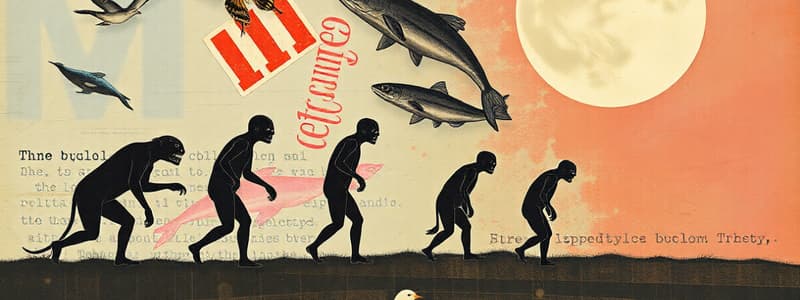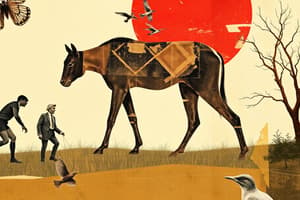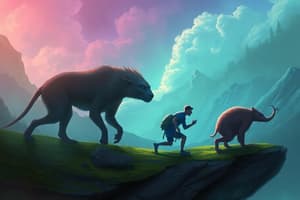Podcast
Questions and Answers
What is the founder effect?
What is the founder effect?
A small group separating from a larger group.
What are the two main points of Darwin's theory of evolution?
What are the two main points of Darwin's theory of evolution?
- Species living today descended from ancestral species in what Darwin called "descent with modification." 2. Natural Selection is a mechanism for evolution.
What is Wallace's theory of evolution?
What is Wallace's theory of evolution?
Over generations, natural selection of inherited traits could give rise to new species.
What is the Fossil Record?
What is the Fossil Record?
What is biogeography?
What is biogeography?
What is convergent evolution?
What is convergent evolution?
What is direct observation?
What is direct observation?
Describe the process of natural selection.
Describe the process of natural selection.
What is artificial selection?
What is artificial selection?
What are homologies?
What are homologies?
Describe the mechanism of natural selection.
Describe the mechanism of natural selection.
What is descent with modification?
What is descent with modification?
What is homology?
What is homology?
What is a homologous structure?
What is a homologous structure?
Define a fossil.
Define a fossil.
What is a vestigial structure?
What is a vestigial structure?
What is an evolutionary tree?
What is an evolutionary tree?
What is an adaptation?
What is an adaptation?
Define evolution.
Define evolution.
Why is the smallest unit of evolution a population?
Why is the smallest unit of evolution a population?
How does genetic variation arise in populations?
How does genetic variation arise in populations?
Explain why genetic variation is necessary for natural selection.
Explain why genetic variation is necessary for natural selection.
What are the equations for Hardy-Weinberg equilibrium (allele and genotype frequency)?
What are the equations for Hardy-Weinberg equilibrium (allele and genotype frequency)?
What are the five conditions needed for Hardy-Weinberg equilibrium?
What are the five conditions needed for Hardy-Weinberg equilibrium?
Describe directional selection.
Describe directional selection.
What is disruptive selection?
What is disruptive selection?
Define stabilizing selection.
Define stabilizing selection.
Explain balancing selection.
Explain balancing selection.
Natural selection is goal oriented and can produce perfect organisms.
Natural selection is goal oriented and can produce perfect organisms.
Why does genetic drift have a greater effect on smaller populations?
Why does genetic drift have a greater effect on smaller populations?
What is a gene pool?
What is a gene pool?
Define a population.
Define a population.
What is MICROevolution?
What is MICROevolution?
What is the bottleneck effect?
What is the bottleneck effect?
What is genetic drift?
What is genetic drift?
What is fitness?
What is fitness?
What is horizontal gene transfer?
What is horizontal gene transfer?
Describe the biological species concept.
Describe the biological species concept.
Define the morphological species concept
Define the morphological species concept
What is the ecological species concept?
What is the ecological species concept?
How does a single species become two species?
How does a single species become two species?
Explain why reproductive isolation is necessary for divergence in populations.
Explain why reproductive isolation is necessary for divergence in populations.
What are the eight mechanisms of reproductive isolation?
What are the eight mechanisms of reproductive isolation?
How does sympatric speciation occur?
How does sympatric speciation occur?
Describe allopatric speciation.
Describe allopatric speciation.
What is speciation?
What is speciation?
What is reproductive isolation?
What is reproductive isolation?
Re-explain the biological species concept.
Re-explain the biological species concept.
What is a hybrid zone?
What is a hybrid zone?
Define polyploidy
Define polyploidy
Define intraspecific.
Define intraspecific.
What is interspecific?
What is interspecific?
What is adaptive radiation?
What is adaptive radiation?
Explain how eukaryotic cells evolved from prokaryotic cells.
Explain how eukaryotic cells evolved from prokaryotic cells.
What are biases in the fossil record?
What are biases in the fossil record?
What are the main steps for the evolution of life on earth?
What are the main steps for the evolution of life on earth?
What is the age of the Earth?
What is the age of the Earth?
When did prokaryotes appear?
When did prokaryotes appear?
When did multicellular eukaryotes appear?
When did multicellular eukaryotes appear?
When did animals appear?
When did animals appear?
When did land plants appear?
When did land plants appear?
How has Earth's environment changed over history and affected living organisms?
How has Earth's environment changed over history and affected living organisms?
Define radiometric dating.
Define radiometric dating.
How does the depth of a fossil help us understand its relative age?
How does the depth of a fossil help us understand its relative age?
Where did the first living cells evolve?
Where did the first living cells evolve?
How does the spatial expression of genes affect pattern formation?
How does the spatial expression of genes affect pattern formation?
How does early development of an organism help us understand evolutionary relationships?
How does early development of an organism help us understand evolutionary relationships?
What are protocells?
What are protocells?
Define hydrothermal vents.
Define hydrothermal vents.
What are alkaline vents?
What are alkaline vents?
What are ribozymes?
What are ribozymes?
Define an endosymbiont.
Define an endosymbiont.
What is the Cambrian explosion?
What is the Cambrian explosion?
What does unicellular mean?
What does unicellular mean?
Define a prokaryote.
Define a prokaryote.
What is a eukaryote?
What is a eukaryote?
Define half-life.
Define half-life.
What is a monophyletic group?
What is a monophyletic group?
How can neutral mutations spread through populations?
How can neutral mutations spread through populations?
What is the principle of parsimony?
What is the principle of parsimony?
Define a molecular clock.
Define a molecular clock.
How does horizontal gene transfer and convergent evolution complicate drawing phylogenetic trees?
How does horizontal gene transfer and convergent evolution complicate drawing phylogenetic trees?
What is binomial nomenclature?
What is binomial nomenclature?
Describe the hierarchy of taxonomic grouping.
Describe the hierarchy of taxonomic grouping.
What is a taxon?
What is a taxon?
Define sister taxa.
Define sister taxa.
What is an analogy?
What is an analogy?
Define a clade.
Define a clade.
Flashcards
Founder effect
Founder effect
small group separating from larger group
Darwin theory of evolution
Darwin theory of evolution
Species descended from ancestral species by natural selection.
Fossil Record
Fossil Record
Collection of life's remains in sedimentary rock layers.
Natural selection
Natural selection
Signup and view all the flashcards
Homologies
Homologies
Signup and view all the flashcards
Convergent evolution
Convergent evolution
Signup and view all the flashcards
Mutation
Mutation
Signup and view all the flashcards
Gene flow
Gene flow
Signup and view all the flashcards
Speciation
Speciation
Signup and view all the flashcards
Adaptive radiation
Adaptive radiation
Signup and view all the flashcards
Gene pool
Gene pool
Signup and view all the flashcards
Macroevolution
Macroevolution
Signup and view all the flashcards
Directional selection
Directional selection
Signup and view all the flashcards
Bottleneck effect
Bottleneck effect
Signup and view all the flashcards
Hybrid zone
Hybrid zone
Signup and view all the flashcards
Biological species concept
Biological species concept
Signup and view all the flashcards
Reproductive isolation
Reproductive isolation
Signup and view all the flashcards
Horizontal gene transfer
Horizontal gene transfer
Signup and view all the flashcards
Interspecific competition
Interspecific competition
Signup and view all the flashcards
Molecular clock
Molecular clock
Signup and view all the flashcards
Clade
Clade
Signup and view all the flashcards
Paraphyletic
Paraphyletic
Signup and view all the flashcards
Polyphyletic
Polyphyletic
Signup and view all the flashcards
Half-life
Half-life
Signup and view all the flashcards
Directional selection
Directional selection
Signup and view all the flashcards
Disruptive selection
Disruptive selection
Signup and view all the flashcards
Stabilizing selection
Stabilizing selection
Signup and view all the flashcards
Vestigial structure
Vestigial structure
Signup and view all the flashcards
Study Notes
Founder Effect
- A small group separates from a larger group.
Darwin's Theory of Evolution
- Species today are descended from ancestral species, called "descent with modification".
- Natural selection is a mechanism for evolution.
Wallace's Theory of Evolution
- Natural selection of inherited traits over generations can create new species.
Fossil Record
- Chronological record of life's remains in sedimentary rock layers.
Biogeography
- Study of the distribution of organisms, past and present.
Convergent Evolution
- Unrelated organisms evolve similar traits when adapting to similar environments.
Direct Observations
- Using the five senses to observe phenomena; capturing information by watching.
Natural Selection
- Individuals with inheritable traits better suited for survival and reproduction pass those traits.
Artificial Selection
- Breeding organisms with desired traits to produce offspring with those same traits.
Homologies
- Similarities in organisms due to common ancestry.
Mechanism of Natural Selection
- Mutations introduce genetic variation. Organisms with higher fitness survive. Descent with modification leads to better adaptation.
Descent with Modification
- Species change over time.
Homology (general)
- Similarity due to shared ancestry.
Homologous Structure
- Similar structure, different function in different organisms, due to shared ancestry.
Analogous Structure
- Similar function, different structure in different organisms, due to similar environmental pressures, not shared ancestry.
Fossils
- Preserved traces or remains of ancient organisms.
Vestigial Structure
- Remnants of structures useful in ancestors, but not useful today.
Evolutionary Tree
- Diagram reflecting hypotheses on evolutionary relationships.
Adaptation
- Trait that increases survival and reproduction in a particular environment.
Evolution
- Gradual change in species over time.
Population as the Smallest Unit of Evolution
- Evolutionary change happens in allele frequencies within interbreeding groups over generations.
Genetic Variation in Populations
- Changes in allele frequencies.
Genetic Variation's Role in Natural Selection
- Provides the diversity of traits that is necessary for selection to act.
Hardy-Weinberg Equilibrium
- p² + 2pq + q² = 1
- p + q = 1
Hardy-Weinberg Equilibrium Conditions
- No selection
- No mutations
- No migration
- Large population
- Random mating
Directional Selection
- Natural selection favors one extreme variation of a trait.
Disruptive Selection
- Natural selection favors both extreme variations of a trait.
Stabilizing Selection
- Natural selection favors intermediate variations, against extremes.
Balancing Selection
- Natural selection maintains multiple phenotypic forms.
Natural Selection is Not Goal-Oriented
- Natural selection cannot create perfect organisms.
Genetic Drift's Effect on Small Populations
- Faster and more impactful in smaller populations.
Gene Pool
- Combined genetic information of a population's members.
Population
- Group of individuals of the same species in the same area.
Microevolution
- Evolutionary change within a species or small group over a short period.
Macroevolution
- Large-scale evolutionary changes over long periods.
Bottleneck Effect
- Reduction in genetic diversity due to a population size reduction (usually random, environmental).
Genetic Drift
- Random change in allele frequencies in smaller populations.
Gene Flow
- Movement of genes between populations.
Migration (genetic perspective)
- Gene movement between populations.
Fitness
- Ability of an organism to survive and reproduce.
Mutation
- Change in DNA sequence.
Horizontal Gene Transfer
- Genes transferred between genomes.
Biological Species
- Groups of populations with potential for interbreeding and producing fertile offspring.
Morphological Species
- Species defined by body shape and structural features.
- Limitation: Degree of dissimilarity is subjective.
Ecological Species
- Species defined by ecological niche.
- Limitation: Similar ecology doesn't always mean species relationship.
Speciation: Single Species Becoming Two
- Reproductive isolation.
Reproductive Isolation's Role in Population Divergence
- Prevents gene flow, allows genetic differences to accumulate.
Mechanisms of Reproductive Isolation
- Habitat isolation
- Temporal isolation
- Behavioral isolation
- Mechanical isolation
- Gametic isolation
- Reduced hybrid viability
- Reduced hybrid fertility
- Hybrid breakdown
Sympatric Speciation
- Speciation within a population without geographic isolation.
- (Polyploidy, habitat differentiation, sexual selection)
Allopatric Speciation
- Geographic isolation leads to speciation.
- Most common mode of speciation.
Speciation
- Formation of new species.
Reproductive Isolation (general)
- Separation preventing interbreeding and fertile offspring.
Biological Species Concept
- Species defined by interbreeding potential.
Hybrid Zone
- Region where species meet and interbreed.
Polyploidy
- Extra chromosome sets in an organism.
Hybrid
- Offspring from crosses between different species.
Intraspecific
- Variation within a single species.
Interspecific
- Competition between different species.
Adaptive Radiation
- Single species evolving into many descendants.
Eukaryotic Cell Evolution from Prokaryotic Cells
- Endosymbiosis (one prokaryotic cell engulfing another).
Biases in the Fossil Record
- [Information omitted as per instructions]
Steps in Life's Evolution
- Nucleotide/amino acid production
- Polymerization (into larger molecules)
- Protocell formation (containing polymers)
- Self-replicating molecules
Age of Earth
- 4.6 billion years.
Appearance of Prokaryotes
- 3.5 billion years ago.
Appearance of Eukaryotes
- 1.8 billion years ago.
Appearance of Multicellular Eukaryotes
- 1 billion years ago.
Appearance of Animals
- ~0.8 billion years ago.
Appearance of Humans
- 2.5 million years ago.
Appearance of Land Plants
- ~0.5 billion years ago.
Effects of Environmental Change on Organisms
- Climate/temperature, atmosphere, landmasses, floods, glaciation, volcanism, meteorites affect organisms through genetic changes.
Radiometric Dating
- Determining absolute age of rock material using radioactive isotopes.
Fossil's Depth and Relative Age
- Deeper strata contain older fossils.
First Living Cells: Location
- Oceans.
Spatial Gene Expression and Pattern Formation
- Affects phenotypes.
Early Development and Evolutionary Relationships
- Reveals shared embryonic features and processes, reflecting common ancestry.
Protocells
- Simple vesicle-like structures.
Hydrothermal Vents
- Heated mineral-rich water openings in the sea floor.
Alkaline Vents
- Deep sea vents with high pH and warm water.
Ribozymes
- Catalytic RNA molecules.
Endosymbiont
- Cell living within a host cell.
Cambrian Explosion
- Rapid diversification of animal species.
Unicellular
- One-celled organisms.
Multicellular
- Organisms with many cells.
Prokaryote
- Cell without a nucleus.
Eukaryote
- Cell with a nucleus and membrane-bound organelles.
Half-Life
- Time for half of a radioisotope to decay.
Monophyletic Group
- Group containing a common ancestor and all descendants.
Neutral Mutations and Population Spread
- Genetic drift can increase the frequency of neutral mutations in populations, even if not affecting organismal fitness.
Principle of Parsimony
- Favors the simplest explanation.
Molecular Clock
- Model estimating evolutionary divergence time using DNA comparisons.
Horizontal Gene Transfer and Phylogenetic Trees
- Complicate drawing phylogenetic trees.
Binomial Nomenclature
- Two-part scientific naming system.
Taxonomic Hierarchy
- Kingdom, Phylum, Class, Order, Family, Genus, Species.
Taxon
- Group of organisms in a classification system.
Sister Taxa
- Groups sharing an immediate common ancestor.
Analogy
- Similarity of function, not shared ancestry.
Homology (repeated)
- Similarity due to shared ancestry.
Clade
- Group of species with a common ancestor and all its descendants.
Paraphyletic Group
- Group with common ancestor but not all its descendants (some are excluded).
Polyphyletic Group
- Group derived from two or more different ancestors.
Studying That Suits You
Use AI to generate personalized quizzes and flashcards to suit your learning preferences.




